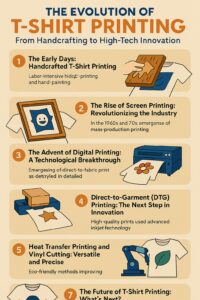
T-shirt printing has come a long way from its humble beginnings. Once considered a niche market for personalized designs, t-shirt printing has evolved into a major industry, transforming the way we express ourselves through apparel. Whether it’s a quirky slogan, a custom design, or a brand’s logo, t-shirt printing has become an art form and a business model that has adapted with the times.
In this article, we’ll explore the evolution of t-shirt printing, from its handcrafted origins to the cutting-edge technology that shapes the industry today. Let’s take a closer look at how t-shirt printing has transformed over the decades, and how the latest innovations—like the Prestige R2 Pro DTF printer—are reshaping the future of custom apparel.
1. The Early Days: Handcrafted T-Shirt Printing
The story of t-shirt printing begins long before digital technology was even a thought. In the early days, t-shirt printing was a labor-intensive process, relying on handcrafting techniques that were both time-consuming and costly. Artists and entrepreneurs would often hand-paint or use block printing methods to transfer designs onto fabric. These early techniques allowed for a great deal of creativity but were limited by time and production scale.
Block printing, for example, involved carving a design into a wooden block, which was then pressed onto fabric. This method was slow, and it had its share of limitations, particularly when it came to producing large quantities of t-shirts with intricate designs. Hand-painting, while allowing for unique and artistic designs, also meant that each piece was one of a kind and could not be mass-produced.
Despite these challenges, handcrafted t-shirt printing allowed for a level of customization that could not be achieved with mass-produced items. It was perfect for personal use, small businesses, and creative individuals looking to create something special.
2. The Rise of Screen Printing: Revolutionizing the Industry
In the 1960s and 1970s, t-shirt printing experienced a significant transformation with the rise of screen printing. Screen printing revolutionized the industry by providing a faster, more efficient method of transferring designs onto fabric, allowing for mass production and broader customization options.
The process involves using a stencil (or screen) to apply layers of ink onto the fabric. Each color in a design requires its own screen, which meant that screen printing could handle multi-color designs much more efficiently than earlier methods. This technique not only reduced the time required to print each t-shirt but also made it possible to produce hundreds or even thousands of shirts with the same design.
Screen printing quickly became the go-to method for printing t-shirts, especially in industries like advertising, music, and fashion. Band t-shirts, event merchandise, and promotional items were all printed using this method. The appeal of screen printing was clear: it was cost-effective, versatile, and capable of producing durable prints that lasted through repeated washes.
However, as the demand for more personalized and custom designs grew, it became clear that screen printing had its limitations. The process required a significant amount of setup, and it wasn’t ideal for small runs or designs with fine details. This led to the development of newer, more advanced printing methods.
3. The Advent of Digital Printing: A Technological Breakthrough
The 1990s saw the emergence of digital printing techniques, which were a technological breakthrough in the world of t-shirt printing. Unlike screen printing, digital printing allowed for direct-to-fabric printing, enabling the application of complex designs with a level of detail that was previously impossible to achieve.
Direct-to-Garment (DTG) printing, one of the most popular digital printing methods, works similarly to an inkjet printer, spraying ink directly onto the fabric. This method offers a high degree of color accuracy, fine detail, and the ability to print in full color without the need for separate screens. With DTG printing, artists and businesses could produce vibrant, multi-colored designs without the costly setup associated with screen printing.
The rise of digital printing brought a new era of t-shirt customization, making it possible for people to print one-off designs without the need for large orders. This method allowed for quick turnaround times, low production costs, and the ability to print on demand—perfect for e-commerce stores and small businesses.
In addition to DTG, other forms of digital printing, such as sublimation and heat transfer printing, also gained popularity. Each method offered different advantages depending on the material and design, further expanding the possibilities for custom apparel.
4. Direct-to-Garment (DTG) Printing: The Next Step in Innovation
Direct-to-Garment (DTG) printing has become one of the most widely used methods in t-shirt printing due to its ability to produce high-quality prints with remarkable accuracy. DTG printers, such as the Prestige R2 Pro DTF printer, utilize advanced inkjet technology to print designs directly onto the fabric. This results in sharp, vibrant prints that can be applied to a wide variety of materials.
The Prestige R2 Pro DTF printer stands out because it offers high-speed, high-quality prints on both light and dark garments, making it a versatile option for businesses looking to expand their offerings. It eliminates the need for screens, setup time, and labor-intensive processes, making it an ideal choice for companies with short-run orders or those looking to offer customizable products on demand.
One of the key benefits of DTG printing is its ability to print small runs with minimal waste. This makes it an attractive option for individuals or businesses who need small quantities or want to experiment with different designs without the risk of overproduction. The ability to print on-demand also ensures that businesses can reduce their inventory costs, resulting in greater flexibility and lower overhead.
5. Heat Transfer Printing and Vinyl Cutting: Versatile and Precise
Another notable development in t-shirt printing is heat transfer printing, which has gained traction for its versatility and ability to print on a variety of fabrics. Heat transfer printing involves applying a design to a transfer paper or vinyl sheet, which is then pressed onto the fabric using heat. This method is particularly effective for printing intricate designs or small runs, as it does not require large-scale equipment or setup.
Vinyl cutting, a form of heat transfer, involves cutting designs out of colored vinyl and applying them to garments using heat. This method is ideal for creating bold, single-color designs or custom lettering and logos. While vinyl cutting doesn’t offer the same level of detail as DTG printing, it remains a popular option for custom t-shirts, especially for businesses with specific branding needs.
Both heat transfer printing and vinyl cutting are ideal for small-scale operations or businesses looking to offer highly customizable products with minimal setup time and low production costs.
6. Sustainable T-Shirt Printing: The Green Revolution
As environmental concerns continue to grow, sustainable t-shirt printing methods have become a priority for many companies. Consumers are increasingly aware of the environmental impact of their purchases, prompting businesses to adopt more eco-friendly practices.
Sustainable t-shirt printing focuses on using water-based inks, organic fabrics, and low-impact processes. Water-based inks are preferred because they do not contain harmful chemicals and have a minimal environmental footprint. Additionally, using organic cotton or recycled materials for t-shirts helps reduce the overall environmental impact of the production process.
Innovations in eco-friendly printing technologies have made it easier for businesses to adopt sustainable practices without sacrificing quality or design. Today, consumers can enjoy vibrant, high-quality prints on eco-conscious garments, and businesses can cater to a growing market of environmentally aware shoppers.
7. The Future of T-Shirt Printing: What’s Next?
The future of t-shirt printing is filled with possibilities, thanks to ongoing advancements in technology. Automation, artificial intelligence, and 3D printing are all on the horizon, promising to further transform the industry.
One exciting development is the potential for fully automated production lines, which could streamline the printing process and make it even more efficient. Additionally, 3D printing could open up new avenues for creating textured, interactive designs that add a new dimension to custom apparel.
As the technology continues to evolve, businesses will have even more opportunities to experiment with new printing methods and offer even more personalized, high-quality products to consumers.
Conclusion
From handcrafted designs to high-tech innovations like the Prestige R2 Pro DTF printer, t-shirt printing has undergone a remarkable transformation. Today’s printing technologies provide greater speed, precision, and sustainability, allowing businesses to meet the demands of a rapidly changing market. As technology continues to evolve, the future of t-shirt printing looks brighter than ever, offering endless possibilities for creativity, customization, and innovation.
Whether you’re starting a custom t-shirt business or simply want to create personalized apparel, understanding the history and future of t-shirt printing will help you make informed decisions and stay ahead of the curve.



